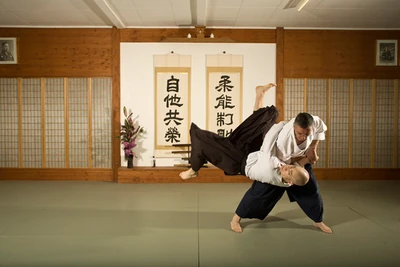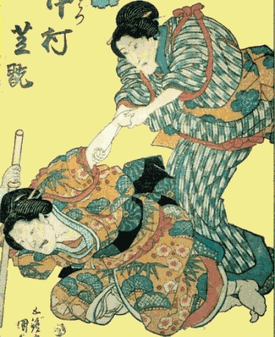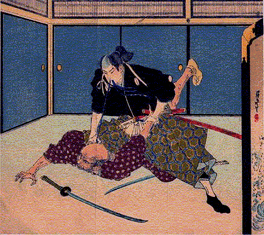| Daitō-ryū Aiki-jūjutsu | |
|---|---|

| |
| Also called | Aiki-jūjutsu, Aikijujutsu |
| Country of origin | Japan |
| Parent arts | Jujutsu |
| Descendant arts | Aikido, Hapkido |
| Focus | Grappling |
Aikijujutsu is a jujutsu discipline that focuses on the Japanese principle of “aiki,” in which a practitioner blends with and defeats an opponent by using one’s internal energy (ki or chi), however, all forms of the art originated with Daitō-ryū Aiki-jūjutsu.
Daitō-ryū Aiki-jūjutsu is a Japanese martial art based on traditional Jujutsu, founded (or restored, the issue is controversial) by Takeda Sōkaku. While many techniques are derived from classic Jujutsu it also includes techniques from Sumo wrestling and Kashima Shinden Jikishinkage-ryū, a school of Japanese swordsmanship. Aikido and Hapkido are both derived from this martial art, although the former adopted more pacifistic ideals while the later maintained the combative mindset.
Aiki, and internal energy are are implied to be subtle in nature, hence the term internal. This has raised a recent point of contention amongst practitioners of the art in that the term "blends with" is firstly, and more importantly perhaps done within oneself first, as in Aiki in yo ho, which in the union of opposites in the Chinese classics, is the fitting together of the 2 ki's, within yourself, to be in balance between yin and yang. In simplified terms, balance in oneself first. This may sound reasonable in theory but difficult to translate to a physical aspect due to the secretive nature of the art as it may require deep understanding of abstract concepts (such as stretch in 6 directions, use of the kua etc etc) in the creation of this 'Aiki body'. This 'Aiki body' requires consistent and specific solo training to create, and is what differentiates whether a practitioner is doing Aiki-jūjutsu or merely something similar looking as constant mimic of the external techniques for training will not result in an 'Aiki body', even though with constant training the physical effects during training conditions may look almost similar to an untrained eye.
In this area of training, it is presently difficult to form a consensus of opinion of whether a person is doing Aiki-jūjutsu or jūjutsu. Daitō-ryū's essence, at it's core, was a closely guarded, long-held family secret and so at the highest level, it was highly secretive in nature. In addition, the abstract concepts made it much more difficult to translate and pass on from teacher to student. The most famous of Takeda's student's, Morehei Ueshiba, the founder of Aikido had recorded instances of 'speaking in riddles' about Aiki. Perhaps this subtle part of the art, on how to reorganize the body from the inside has not been properly emphasized nor "translated", and as such not yet adopted by a majority of the modern day practitioners of the art.
History[]
Conflicting stories state that either Shinra Saburo Minamoto (1045-1127) or a doctor in 1180 lay down the

foundation for daito-ryu aikijujutsu (considered the oldest aikijujutsu in Japan) by discovering the mechanics of the joints and muscle attachments while dissecting cadavers. From these discoveries, joint-locking skills, techniques to cause muscle twisting, and strikes to vital points were formalized and perfected during battle.
Shortly before 1900, Takeda Sokaku — whose most notable

student was aikido’s founder, Morihei Uyeshiba — modified daito-ryu by combining his knowledge of daito-ryu experience with sumo kenjutsu (swordsmanship) and several empty-hand martial arts. In the late 1800s, he named his style daito-ryu aikijujutsu. Takeda Sokaku then honed the art by teaching military officers, police officials and aristocrats.
Similar to bujinkan, aikijujutsu was founded as a “dark,” secretive and highly combative samurai art. Unarmed fighters used aikijujutsu to kill samurai in full armor.
It is known that the personal bodyguards to the emperors and shogun of Japan have been trained in Daito-Ryu for over 1,000 years as the primary method of defending against both armed and unarmed attackers.
Techniques[]
Daitō-ryū Aiki-jūjutsu uses three main sets of techniques: jujutsu (hard); aiki no jutsu (soft); and the combined aikijujutsu (hard/soft). Hard techniques include strikes and kicks, soft techniques include joint locks and throws, and hard/soft techniques include combinations of both.
Daitō-ryū Aiki-jūjutsu emphasizes dealing with an attacker as quickly as possible with either a joint lock or a throw. The art is also characterized by strikes at deceptive angles and at pressure points in order to set up other techniques. Like many Korean martial arts, practitioners aim to use their attacker's momentum against them.